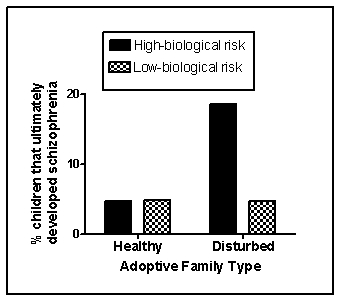Scenario II
The following scenario presents fabricated data consistent with the results of the following study:
Tienari, P., Wynne, L. C., Sorri, A., Lahti, I., Läksy, K., Moring, J., & ... Wahlberg, K. (2004) . Genotype-environment interaction in schizophrenia-spectrum disorder: Long-term follow-up study of Finnish adoptees. The British Journal of Psychiatry, 184(3) , 216-222. doi:10.1192/bjp.184.3.216
Schizophrenia affects approximately 1 percent of the general population and is characterized by the profound disruption of basic psychological processes; a distorted perception of reality;, altered or blunted emotional affect; and disturbances in thought, motivation, and behavior. The symptoms of schizophrenia are varied and are typically classified as either positive or negative. Positive symptoms of schizophrenia refer to thoughts and behaviors typically not observed in those without the disease, and can include things like delusions (patently false beliefs) , hallucinations (false perceptual experiences) , and disorganized speech. Negative symptoms of schizophrenia are deficits or disruptions in normal behaviors, such as social withdrawal. Cognitive deficits in executive functioning, attention span, and working memory also may be observed.
The symptoms of schizophrenia usually begin in late adolescence and the disease has a strong genetic component. Over the years, a number of biological factors have been linked to schizophrenia, although none alone adequately accounts for the disorder. One such example is the dopamine hypothesis, which states that schizophrenia is related to an excess in dopamine activity. Another theory points to enlarged brain ventricles and progressive cortex tissue loss as predictive of schizophrenia, although only a minority of persons with schizophrenia have enlarged ventricles, this structural anomaly can appear in those without the disease, and dopamine antagonists also may produce this effect.
Although research into the environmental determinants of schizophrenia has focused largely on the prenatal environment, psychological and social factors also contribute. Tienari et al. (2004) compared the risk of developing schizophrenia in children adopted into healthy versus disturbed families, the latter characterized by extreme conflict, volatile relationships, and communication deficits. Some of these children under investigation were identified as at-risk genetically for schizophrenia because their biological mothers were schizophrenic. The remainder was classified at low risk. The investigators utilized a longitudinal design and obtained the diagnostic status of the children with respect to schizophrenia when they reached young adulthood. Fabricated results consistent with this study are shown in Figure 15.2
Figure 15.2 
-(Scenario II) The fabricated results consistent with those obtained by Tienari et al. (2004) and shown in Figure 15.2 suggest that:
Definitions:
Residual Interest
The remaining interest in assets after all other claims have been satisfied, often related to securitization transactions.
Expected Exit Value
The anticipated amount to be received from an investment at the point of exit, such as selling an asset or closing a position.
Fair Value
An estimate of the market value of an asset or liability, based on current market prices.
Q1: Aerobic exercise is a causal factor in
Q1: One criticism of the medical model of
Q7: Lisa has a very stormy relationship with
Q16: Schizophrenic hallucinations most often involve the sense
Q25: Married people have a lower risk of
Q50: The levels of impairment associated with psychological
Q60: Researchers attempt to overcome the effects of
Q110: Men with a Type _ behavior pattern
Q124: The Diagnostic and Statistical Manual of Mental
Q145: Elana has just begun traditional psychoanalysis. She